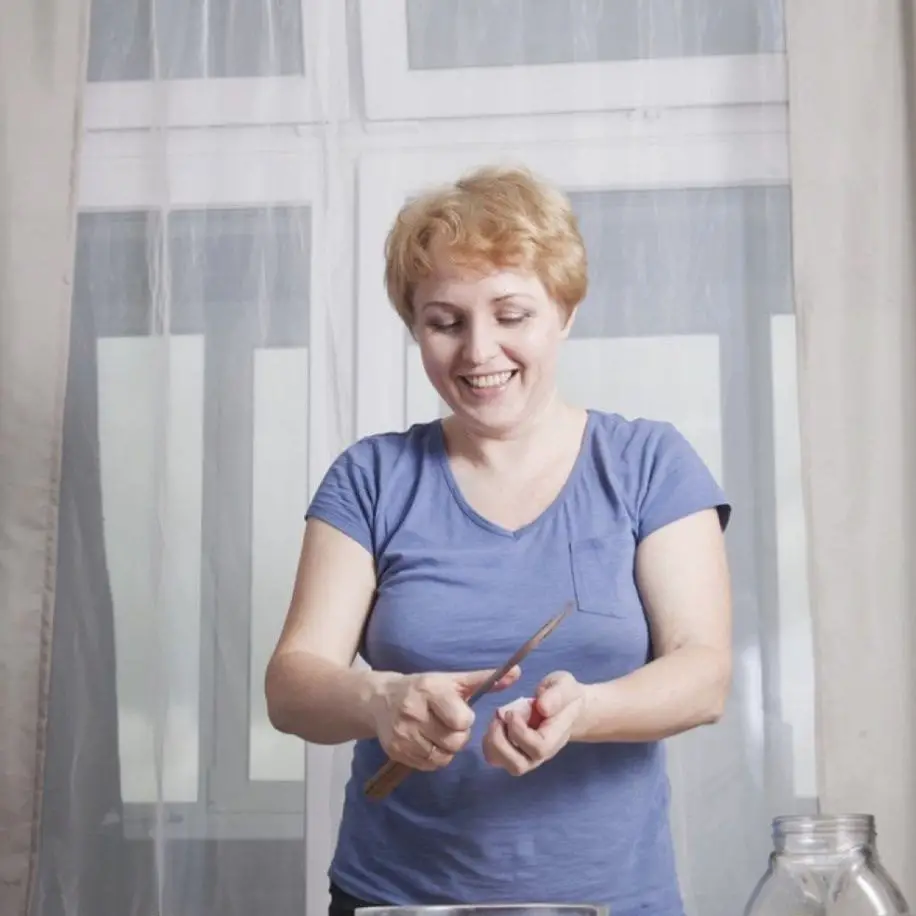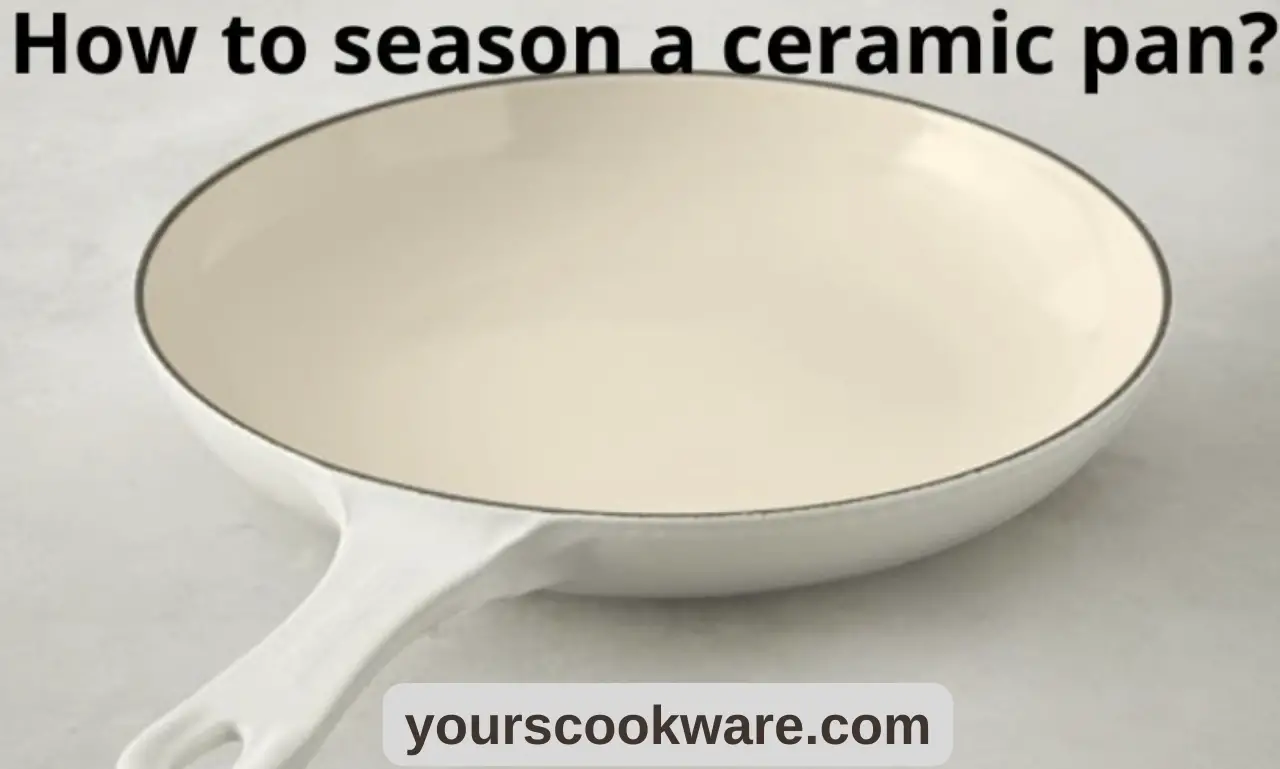Wanna know how to make a Ceramic Pan Non Stick again? Let’s explore! There are many ways to restore the nonstick cooking surface of a ceramic pan. I’ll share the easiest way so that everyone should do it. You need to salt and vegetable oil to do this. Let’s start.
First Step: Put three pinches of salt on the ceramic pan.
Second Step: Rub it with a soft towel or a kitchen tissue. (Ten Minute)
Third Step: Wash the pan thoroughly with warm water.
Fourth Step: Heat the pan over medium heat and add a tablespoon of vegetable oil.
Fifth Step: Spread the vegetable oil evenly over the pan’s surface.
Sixth Step: Allow the oil to heat up and smoke slightly.
Last Step: Stop the heat and Wipe the oil with a paper towel.
This method helps restore the non-stick coating and creates a natural seasoning on the pan.

So how to Make a Ceramic Pan Non Stick again
Making a ceramic pan non-stick again can be a bit tricky, but here are some more ways you can try to make your pan non-stick again:
- Oil Seasoning.
- Vinegar and Baking Soda.
- Ceramic Coating Renewal Kit.
- Using Heavy-Duty Oven Cleaner
- Applying Salt
- Using Baking Soda and Liquid Dish Soap
- Using Salt and Baking Soda
Oil Seasoning
- Wash the ceramic non-stick pan with warm, soapy water and dry it thoroughly.
- Add a small amount (about a teaspoon) of oil to the pan’s surface and use a paper towel to spread it evenly over the surface.
- Heat the pan on the stovetop at low heat for about 2-3 minutes until the oil starts to smoke, and then remove from heat.
- Repeat steps 2 and 3 about 4-5 times or until a visible film has developed on the pan’s surface.
- Allow the pan to cool to room temperature, and wipe off any excess oil with a paper towel.
Following these steps should restore the non-stick qualities of your ceramic pan.
You may also like to read: How To Season A Ceramic Pan: Kitchen Hacks
Using Baking Soda and Vinegar
Sprinkle a generous amount of baking soda over the pan’s surface and add enough vinegar to create a paste. Allow the mixture to bubble and foam for a few minutes before scrubbing the pan with a soft sponge or brush. Rinse the pan thoroughly with water and dry it with a soft towel.
Ceramic Coating Renewal Kit
Consider purchasing a ceramic coating renewal kit if the above methods do not work. These kits usually have a special cleaner and a spray-on coating to make your pan non-stick again.
Using Heavy-Duty Oven Cleaner
You’ll need to apply the cleaner to the pan, let it sit for some time, and then scrub it with a soft sponge or brush. Rinse the pan thoroughly with water and dry it with a soft towel.
This method can be effective for removing stubborn buildup and restoring the pan’s non-stick properties.
Applying Salt
Salt is a natural abrasive that can remove food particles and buildup from a ceramic pan.
Sprinkle a generous amount of salt over the pan’s surface and add a small amount of water to create a paste.
Use a soft sponge or brush to scrub the pan with the salt paste, focusing on areas with heavy buildup. Rinse the pan thoroughly with water and dry it with a soft towel.
Using Baking Soda and Liquid Dish Soap
Baking soda and liquid dish soap can be used together to create a powerful cleaning solution for a ceramic pan.
Sprinkle a generous amount of baking soda over the pan’s surface and add a small amount of liquid dish soap. Add enough water to create a paste, and use a soft sponge or brush to scrub the pan with the mixture. Rinse the pan thoroughly with water and dry it with a soft towel.
Using Salt and Baking Soda
- Mix salt and baking soda in a bowl and add enough water to create a paste.
- Use a soft sponge or brush to scrub the pan with the paste.
- The salt adds extra abrasiveness, while the baking soda helps to break down stubborn stains and residue.
- Rinse the pan thoroughly with water and dry it with a soft towel.
- This method can be particularly effective for removing burnt-on food particles and restoring the pan’s non-stick properties.
Is It Safe Using Slightly Scratched Ceramic Pans?
Yes, slightly scratched ceramic pans are safe if the scratch is not so deep. The deeper scratches can harbour bacteria, acidic food reacts with aluminium properties, and reduce the pan’s durability.
So, It is not ideal to use slightly scratched ceramic pans. But If you continue using a slightly scratched ceramic pan, clean it thoroughly after each use and apply the abovementioned methods.
Why Do Ceramic Pans Lose Their Non-Stick Properties?
Ceramic non-stick pans have become increasingly popular due to their non-stick properties. However, over time, you may notice that your ceramic pan is losing its non-stick properties, making cooking and cleaning more difficult. Here are some reasons why ceramic pans lose their non-stick properties:
High Heat
Ceramic pans are not designed to be used in high-heat settings. High heat can cause the non-stick coating to break down and lose effectiveness. If you want to maintain the non-stick properties of your ceramic pan, it is crucial to utilize it only in low to medium heat settings.
Abrasive Cleaning
Cleaning your ceramic pan with abrasive materials such as steel wool or abrasive cleaning powders can cause the non-stick coating to wear off. Instead, use a soft sponge or cloth to clean your pan and avoid harsh cleaning materials.
Overheating
Leaving an empty ceramic pan on a hot burner for too long can cause the non-stick coating to break down. Always add oil or food to the pan before heating it, and avoid leaving it on the burner for extended periods.
Metal Utensils
Using metal utensils on your ceramic pan can scratch the non-stick coating, causing it to break down over time. Instead, use silicone, nylon, or wooden utensils when cooking with your ceramic pan.
Wear and Tear
Like any other cookware, ceramic pans will eventually wear out with regular use. Even with proper care and use, the non-stick coating may break down after several years, making cooking and cleaning with the pan more difficult.
By taking proper care of your ceramic pan and avoiding high heat, abrasive cleaning, overheating, metal utensils, and wear and tear, you can extend the life of the non-stick coating and continue to enjoy the benefits of your ceramic cookware.

How Do You Take Care Of Your Ceramic Pans?
Following the manufacturer’s care and use guidelines, such as the recommended cooking oil, is essential when using ceramic cookware. Moreover, remember that some types of cookware, such as anodized aluminium and ceramic, are dishwasher-safe, while others, like cast iron, require specific care.
Here are some tips on how to take care of ceramic pans:
Use the right utensils
Avoid using metal utensils, which can scratch the ceramic surface. Instead, use wooden, silicone, or nylon utensils to protect the non-stick coating.
Preheat the pan
Before cooking, preheat the ceramic pan on low to medium heat for a few minutes. Avoid high heat, as it can damage the non-stick surface and cause food to stick.
Use minimal oil or fat.
Ceramic pans require little to no oil or fat for cooking, thanks to their non-stick surface. However, a small amount of oil or fat can be used to enhance the flavour of the food.
Let the pan cool down.
After cooking, allow the pan to cool down before placing it in water or washing it. Sudden temperature changes can cause the ceramic coating to crack.
Hand wash the pan
Although some ceramic pans claim to be dishwasher safe, it’s best to hand wash them gently with warm, soapy water and a soft sponge. Avoid using abrasive cleaning materials, such as steel wool, which can scratch the non-stick surface.
Store the pan properly.
When storing ceramic pans, avoid stacking them directly on top of each other, as this can cause scratches. Instead, place a paper towel, cloth, or pan protector between the pans to prevent damage.
Regularly check for damage.
Inspect your ceramic pans for any signs of damage, such as chipping, peeling, or discolouration. If you find any damage, replace the pan to avoid health risks and maintain optimal cooking performance.
By following these guidelines, you can prolong the life of your ceramic pans and enjoy their non-stick properties for many years.
Should I throw away my scratched ceramic pan?
The answer is both yes and no. If the scratch is small and not so deep, then you can continue using the pan. But season it first before using a scratched ceramic pan.
If the pan has a big scratch and the scratch is deep enough, then get rid of this pan. Because if the underlying metal becomes exposed due to scratches, it might react with certain foods or release particles during cooking.
If you discard your scratched ceramic pan, consider repurposing it for other uses around your home instead of throwing it in the trash or recycling bin. However, if the scratches are deep or the pan is severely damaged, replace it with a new one.

Can you use olive oil in ceramic pans?
Yes, you can use olive oil in ceramic pans. Ceramic nonstick cookware is compatible with various types of cooking oils and fats.
When using olive oil in ceramic pans, it is recommended to use regular olive oil instead of extra virgin olive oil, as the latter has a low smoke point and may cause the pan to overheat or the oil to smoke. Safe alternatives to extra virgin olive oil include regular olive oil, avocado oil, butter, and ghee.
When cooking with ceramic pans, using the correct heat settings and avoiding overheating the pan is essential.

How Long Does Ceramic Pan Last?
Generally, ceramic-coated non-stick pans have an average lifespan of 1 to 5 years. The average lifespan varies depending on usage, quality, and maintenance.
If you want to ensure that your ceramic pan lasts as long as possible, it’s crucial to adhere to the correct cleaning and maintenance protocols.
Most quality cookware, including ceramic pans, should be hand-washed to promote longevity.
Regular maintenance and proper cleaning are necessary; some of the best ways to clean ceramic pans include gentle scrubbing with a non-abrasive sponge and mild dish soap.
Conclusion
In conclusion, if your ceramic pan is only slightly scratched and still performs well, you may continue using it with caution. However, if the scratches are deep or the pan’s performance is compromised, it’s advisable to replace it.

I am Linda. A housewife and a writer, and also the founder of this site. I love cooking and collecting cookware sets. I’ve been blogging since 2020, and in this blog, you can find cookware-related problems and solutions, cookware reviews, safe cookware sets, and more.
I have put a lot of effort into gathering here the experience and knowledge that I have, and I want to help every reader.


